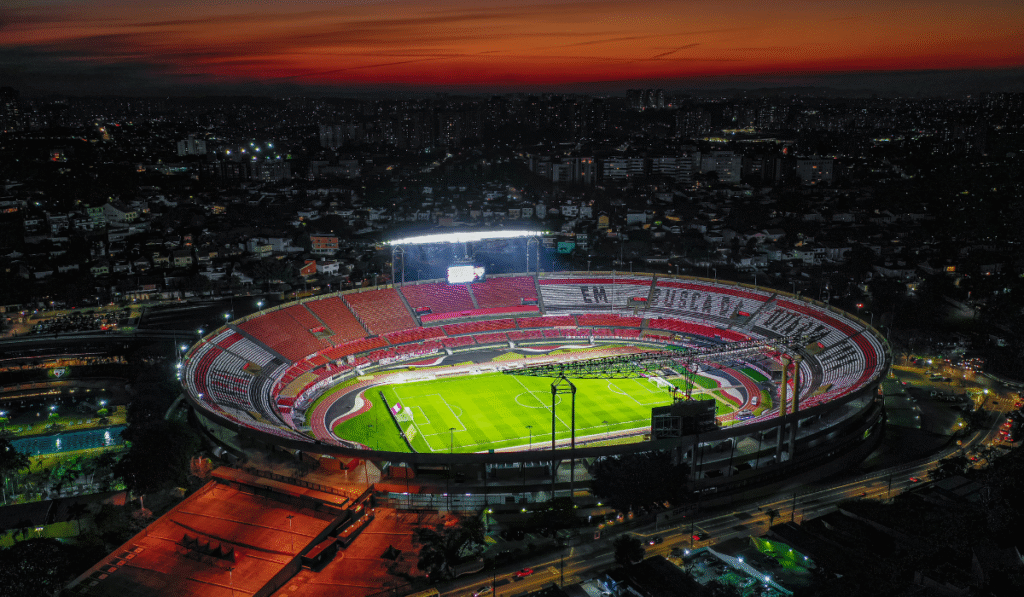When it comes to sports, America loves to go big — big games, big crowds, and even bigger stadiums. From the roaring fans at college football games to the dazzling halftime shows, the country’s stadiums are not just venues; they’re monuments to passion, tradition, and architectural excellence.
In this guide, we’ll explore the largest stadiums in America, ranked by seating capacity. These colossal arenas host millions of fans each year, shaping some of the most unforgettable moments in sports history.
Whether you’re a football fanatic, a concertgoer, or an architecture lover, this list of the top 10 largest stadiums in America will leave you amazed at how massive these arenas truly are.
1. Michigan Stadium – “The Big House”
- Location: Ann Arbor, Michigan
- Capacity: 107,601
- Opened: 1927
- Home Team: Michigan Wolverines (NCAA Football)
There’s no surprise that Michigan Stadium, nicknamed “The Big House,” tops the list as the largest stadium in America and the third-largest in the world.
This legendary venue is home to the University of Michigan Wolverines and regularly hosts crowds exceeding 100,000 passionate fans. The atmosphere during a Michigan–Ohio State rivalry game is nothing short of electric.
Fun Fact: The Big House once hosted an NHL Winter Classic and even a soccer match featuring Manchester United, proving its versatility beyond football.
2. Beaver Stadium
- Location: University Park, Pennsylvania
- Capacity: 106,572
- Opened: 1960 (expanded multiple times)
- Home Team: Penn State Nittany Lions (NCAA Football)
The Penn State Nittany Lions play in one of the most intimidating stadiums in college football. Beaver Stadium is known for its “White Out” games, where over 100,000 fans dressed in white create a sea of energy and noise.
Its steep seating design ensures everyone has a great view of the field — and the sound reverberates like thunder.
Fun Fact: Beaver Stadium is named after former Pennsylvania governor James A. Beaver.
3. Ohio Stadium – “The Horseshoe”
- Location: Columbus, Ohio
- Capacity: 102,780
- Opened: 1922
- Home Team: Ohio State Buckeyes (NCAA Football)
Known affectionately as “The Horseshoe” due to its distinctive shape, Ohio Stadium is one of the most iconic venues in college sports.
It’s not just about football — the stadium has hosted concerts for legends like The Rolling Stones, U2, and Taylor Swift.
Fun Fact: When it opened in 1922, Ohio Stadium was one of the first large-scale reinforced concrete structures in the world.
4. Kyle Field
- Location: College Station, Texas
- Capacity: 102,733
- Opened: 1927
- Home Team: Texas A&M Aggies (NCAA Football)
Everything’s bigger in Texas — and Kyle Field proves it. As one of the largest stadiums in America, it’s the centerpiece of Texas A&M University’s legendary football culture.
Aggie fans are known for their loyalty, performing the famous “12th Man” tradition — where the entire crowd symbolically stands ready to support their team.
Fun Fact: The stadium underwent a massive $485 million renovation completed in 2015, transforming it into one of the most advanced sports facilities in the world.
5. Tiger Stadium – “Death Valley”
- Location: Baton Rouge, Louisiana
- Capacity: 102,321
- Opened: 1924
- Home Team: LSU Tigers (NCAA Football)
At Tiger Stadium, football isn’t just a game — it’s a religion. Known as “Death Valley,” this Louisiana landmark becomes one of the loudest places on Earth during a night game.
Its design traps sound, creating a deafening atmosphere that shakes the ground. Players often describe the roar of LSU fans as an experience you can feel as much as hear.
Fun Fact: The stadium’s original capacity was only 12,000 — it’s grown nearly tenfold since then.
6. Darrell K Royal–Texas Memorial Stadium
- Location: Austin, Texas
- Capacity: 100,119
- Opened: 1924
- Home Team: Texas Longhorns (NCAA Football)
Another Texas giant, the Darrell K Royal–Texas Memorial Stadium represents the pride of the University of Texas. Its burnt orange sea of fans creates one of the most recognizable college football visuals in the nation.
The recent renovations have enhanced fan experience with advanced technology, larger video boards, and improved amenities.
Fun Fact: The stadium doubles as a war memorial honoring Texans who served in World War I and subsequent conflicts.
7. Bryant–Denny Stadium
- Location: Tuscaloosa, Alabama
- Capacity: 100,077
- Opened: 1929
- Home Team: Alabama Crimson Tide (NCAA Football)
Home of the Alabama Crimson Tide, Bryant–Denny Stadium is synonymous with dominance. Under the leadership of legendary coach Nick Saban, it has witnessed countless championship moments.
Game days here are a southern spectacle — complete with tailgating, marching bands, and the famous “Roll Tide” chant echoing through the stands.
Fun Fact: The stadium is named after Coach Paul “Bear” Bryant and former university president George Denny.
8. Darrell K Royal–Texas Memorial Stadium (duplicate removed → next is Rose Bowl)
8. Rose Bowl Stadium
- Location: Pasadena, California
- Capacity: 88,565
- Opened: 1922
- Home Team: UCLA Bruins (NCAA Football)
The Rose Bowl isn’t just a stadium — it’s an American icon. Famous for hosting the annual Rose Bowl Game and numerous Super Bowls, it’s one of the most historic sports venues in the country.
It’s also hosted Olympic events, World Cup matches, and legendary concerts, making it a cultural as well as sporting landmark.
Fun Fact: The Rose Bowl hosted the 1994 FIFA World Cup Final — the most attended final in World Cup history.
9. Ben Hill Griffin Stadium – “The Swamp”
- Location: Gainesville, Florida
- Capacity: 88,548
- Opened: 1930
- Home Team: Florida Gators (NCAA Football)
Known to fans as “The Swamp,” this stadium is famous for its heat, humidity, and roaring crowd. When packed, it’s one of the most intimidating environments in college football.
The Gators’ success under coaches like Steve Spurrier and Urban Meyer turned this stadium into a fortress of victory.
Fun Fact: The nickname “The Swamp” came from Spurrier himself, who said, “Only Gators get out alive.”
10. Cotton Bowl Stadium
- Location: Dallas, Texas
- Capacity: 88,500
- Opened: 1930
- Home Team: Formerly SMU Mustangs (now neutral-site games)
The Cotton Bowl Stadium is a cornerstone of Texas sports history. It hosted the annual Red River Showdown between Texas and Oklahoma for decades and continues to be a hub for major events, including concerts and international soccer matches.
Fun Fact: The stadium once hosted the legendary 1963 NFL Championship and was home to the Dallas Cowboys in their early years.
Why Stadiums Matter in American Culture
The largest stadiums in America represent more than concrete and steel — they embody community pride, tradition, and emotion.
From tailgate parties to historic championships, these venues are where memories are made. They contribute billions to local economies, host world-class concerts, and stand as architectural marvels.
Final Thoughts
From the colossal Michigan Stadium to the historic Rose Bowl, the largest stadiums in America are living symbols of the nation’s love for sports, unity, and celebration.
Each stadium tells a story — of triumphs, heartbreaks, and unforgettable roars that shake the ground. Whether you’re there for football, a concert, or just to feel the energy of the crowd, stepping into one of these arenas is an experience you’ll never forget.
Also Read: 5 Best States to Live in USA in 2025






